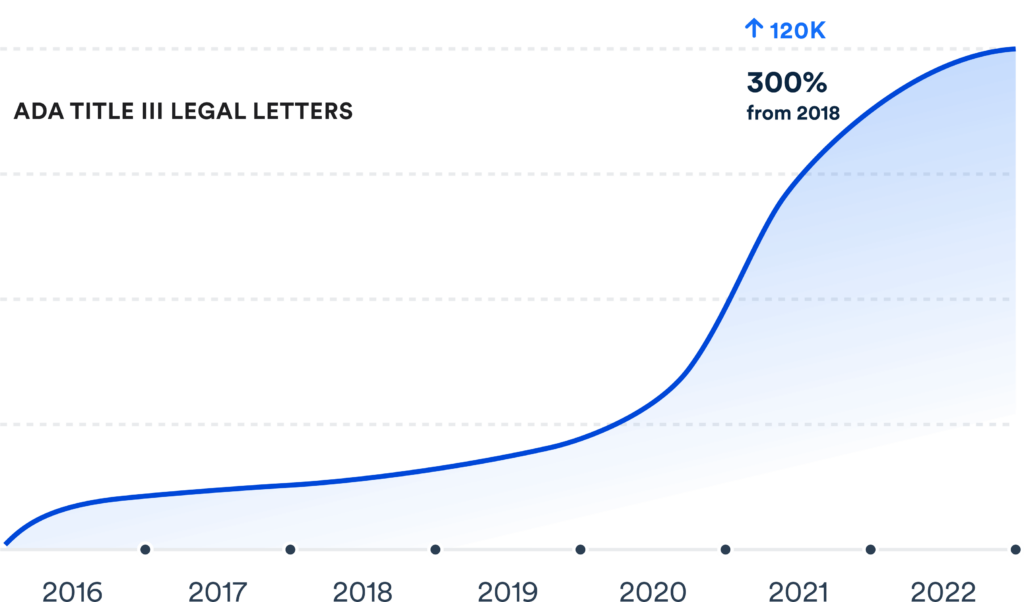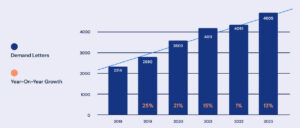In the present day, thanks to the Americans with Disabilities Act (ADA), it is a requirement for all business websites to be accessible to individuals with disabilities.
The legislation forbids discrimination grounded in disability within entities categorized as “public accommodations,” encompassing both online platforms and physical establishments.
Individuals with disabilities, particularly those who are blind or visually impaired, have been pursuing legal action against businesses due to challenges in website accessibility, with a considerable number of them achieving success in their cases.

Web accessibility refers to making websites usable for people with disabilities. It involves designing and developing websites in a way that people with disabilities, such as those with visual, auditory, motor, and cognitive impairments, can perceive, understand, navigate, and interact with the website and its content.
Web accessibility ensures that everyone has equal access to information and services on the web, regardless of their abilities. This includes individuals who use assistive technologies, such as screen readers, to access the web.
YES! It’s the law, do not fall victim to an ADA non-compliance lawsuit. In 2018, the DOJ clarified that websites are considered places of public accommodation and must comply with ADA Title III. In 2022, the DOJ reaffirmed it and recommended WCAG 2.1 AA as the best practice.
The ADA is the Americans with Disabilities Act, an American civil rights law passed in 1990. The law prohibits discrimination against individuals with disabilities in all areas of public life, including jobs, schools, transportation, and all public and private places open to the general public. Since 2018, the ADA also covers websites, as they’re considered public places of accommodation. That is why making your website accessible is crucial for meeting ADA legal requirements.
It’s important to note that the ADA does not specify the criteria for a compliant website, yet today’s industry standard is to adhere to the Web Content Accessibility Guidelines 2.1 (WCAG).
The WCAG is a technical guidebook explaining how websites should look and operate for people with disabilities. So, by following the WCAG guidelines, you are making your website ADA-compliant.
Additional resources:
ADA
The ADA is the Americans with Disabilities Act, an American civil rights law passed in 1990. It’s America’s most important law regarding accessibility and civil rights for people with disabilities. In 2018, the DOJ clarified that the ADA covers web accessibility.
WCAG
The Web Content Accessibility Guidelines (WCAG) is a massive guidebook that explains how accessible websites should look and operate for people with disabilities. While it is not stated in the ADA, the WCAG has been widely accepted as the industry standard for being
ADA-compliant.
Web Accessibility Lawsuit Numbers and Trends
In recent years, there has been a surge in state court lawsuits regarding web accessibility. 2023 saw a record-breaking number of lawsuits and demand letters under the Americans with Disabilities Act (ADA), with 4,605 lawsuits filed. It is estimated that only 3% of demand letters go to trial, as the majority, approximately 97%, are settled beforehand. This indicates that over 100,000 business owners received demand letters in 2023 for failing to make their websites accessible. Moreover, organizations and businesses can be fined up to $150,000 for ADA violations, while the average ADA website lawsuit settlement typically ranges “from $20,000 to $50,000.”
You can quickly and easily scan any domain for free using accessScan by clicking here.
accessScan is a free audit tool that lets you check if a website is compliant. You just need to insert your domain through accessScan and click ‘Get Audit’.
Within seconds you will receive the website’s compliance status. You can then download the full report.
There are multiple free or low cost plugins available. However they only provide you with 10-15% of the accessibility you need in order to become compliant.
Another option are manual accessibility services that do bring you up to full compliance. But they can cost $20,000 to $40,000 per website. They can also take several weeks or months to implement. The worst part of the manual accessibility services are the tedious and costly maintenance. Imagine spending all of that time and money. Then realizing that every time you want to make a change or revision to your site, you have to either spend thousands of dollars or sacrifice a significant amount of the accessibility that you worked so hard to attain.
Those options leave 99% of businesses without a feasible solution. This makes them easy targets for lawsuits and prevents them from helping people with disabilities.
The most cost effective solution is to leverage my partnership with Guardian Insight Group and accessiBe. Guardian Insight Group provides full service web development and support and accessiBe provides a simple yet effective ADA compliance tool and together they provide a complete ADA solution.
⏷ Go to the next section for a cost-effective solution. ⏷


Inaccessible websites face serious legal consequences
With exponential growth in web accessibility, legal actions have a widespread effect across industries, with small and medium businesses in the center.
Lawsuit numbers are estimated to continue to increase as the need to enable accessible digital experiences becomes more prominent.


 View ADA Overview Video
View ADA Overview Video 



